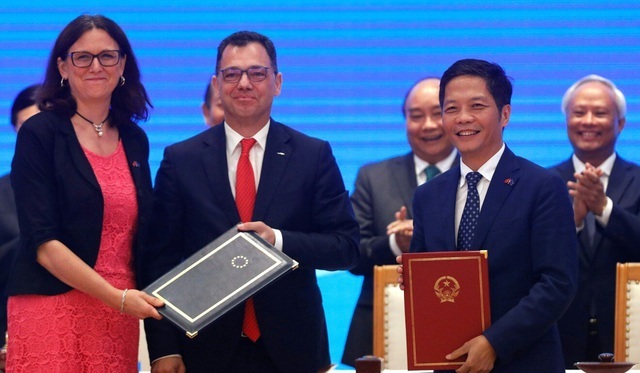
Source: Vietnamnet.vn
Experts said the tax cut agreement will boost European investment in Vietnam – one of the leading destinations in Asia.
The EU – Vietnam free trade agreement will reduce or eliminate 99% of tariffs on goods traded between the two parties. For the textile industry, 77.3% of tariffs will be lifted after 5 years and the remaining 22.7% after 7 years.
According to the President of the European Chamber of Commerce in Vietnam, Nicolas Audie: “The free trade agreement between Vietnam and the EU (EVFTA) comes at the right time for European companies.”
Expected to take effect in July, EVFTA will open Vietnamese services, including the postal, banking, shipping and public procurement markets. This is the second EU agreement with a member of ASEAN after Singapore, and is a rare agreement with a developing country.
|
|
|
The signing ceremony of EU-Vietnam Free Trade Agreement at the Government Office in Hanoi. Photo: Reuters |
This agreement will be of great benefit to many Vietnamese companies that can introduce their products to the European market.
Mr. Audie, a lawyer who has been working in Vietnam since 1995, added: “It can be considered as a roadmap to recover. This alliance will give European companies more access to one of the fastest growing economies in the world at a time when only a few are open to businesses. ”
He said businesses in Vietnam were able to quickly recover because the country of Vietnam successfully handled the Covid-19 pandemic.
Mr. Audie also predicted that EU investment in Vietnam will increase in the coming months.
He said European companies will soon have better access to Vietnam, a growing middle-class consumer market, as well as thriving service sectors, such as higher education, telecommunications and banking. row.
According to the European Commission, Vietnam is the EU’s second largest trading partner in ASEAN after Singapore, with trade transactions worth 49.3 billion euros ($ 56 billion) for goods and more than 3 billion euros for services. According to the Vietnamese government, the total value of Vietnam’s import-export with China is at US $ 517.26 billion.
Production still relies on Chinese supply chains?
Even as many in the region welcome a free trade agreement between the European Union and Hanoi to open up new economic possibilities, some analysts say the deal is still hard to come by. possibility of becoming a “silver bullet” for the recovery after Covid-19 of Vietnam.
Trinh Nguyen, a senior economist in Asia at Natixis – French investment and business bank – said the increase in Vietnam’s exports was due to EVFTA likely being offset by its reliance on Chinese imports for production.
To reduce this dependency, according to Trinh Nguyen, Vietnam needs to improve higher education and promote training and localization of suppliers.
Economists of Natixis said that Vietnam’s dependence on Chinese imports has increased over the years. Vietnam’s link with China increased significantly from 2014 to 2018 compared to other ASEAN countries.
According to Vietnamese customs data, Vietnam’s textile production depends largely on China, such as apparel fabric. Last year, Vietnam exported textiles worth US $ 1.59 billion to China and imported 11.52 billion US dollars of input materials.
Mr. Nguyen said that the free trade agreement stipulated rules of origin for textiles will force many supply chains to move to Vietnam, although this is a short-term concern for the textile industry as currently. Imported raw materials are now cheaper. “I hope to have more capital inflows to increase domestic input in the economy,” Mr. Trinh Nguyen added.
Although tensions between the United States and China today coupled with the supply chain crisis after the Covid-19 pandemic have prompted governments and many analysts to call for diversification of supply chains to reduce reliance on China but according to Trinh Nguyen, Vietnam will only be able to absorb the areas it aims at, such as textiles, footwear and electronics. And even in electronics, manufacturing requires large labor force mobilization, Vietnam is still not able to achieve the same scale as China as well as existing supply links.
Deng Yingwen, Director of the Center for Southeast Asian Studies at Jinan University commented: “Compared to China, the Vietnamese market is very small with a population of 100 million, only slightly larger than the region. autonomous southwest of China, Guangxi. Foreign companies are unable to relocate from China due to the large Chinese market and large production capacity. ”
Yet risks still come to China
However, China still cannot avoid the effects of trade agreement between Vietnam and EU. An article titled “Considerations and implications of the Vietnam-EU FTA” published in May in China wrote that the competitiveness of some of China’s main products in the market. The EU – such as textiles, home appliances and footwear – will be affected when the trade agreement between Vietnam and the EU comes into effect. Currently, Vietnam is the third largest garment exporter in the world, after China and Bangladesh.
Some analysts said that it is likely that European companies will increase investment in Vietnam and reduce investment in China, which is a matter of concern.
Beverage company Saigon Cider is currently very optimistic and said that: “The free trade agreement between Vietnam – EU is really good news for us and Vietnamese businesses.”

